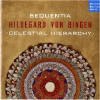Texte paru dans: / Appeared in:

Fanfare Magazine: 37:3 (01-02/2014)
Pour
s'abonner / Subscription information
Les abonnés à Fanfare Magazine ont accès aux archives du
magazine sur internet.
Subscribers to Fanfare Magazine have access to the archives of the magazine
on the net.
DHM
88765468642

0887654686428
(ID313)
Consultez toutes les évaluations recensées pour ce cd
~~~~ Reach all the evaluations located for this CD
After a long delay, the late Barbara Thornton’s desire to record the complete works of Hildegard of Bingen (1098–1179) has been finished by her ensemble. In addition to two versions of the morality play Ordo Virtutum (8:6 and 22:1), this ensemble has recorded all 77 symphoniae. The completion of this series after a delay of 16 years must be related to Hildegard’s elevation last fall to the distinction of a Doctor of the Church, which placed her feast day in the universal calendar, not just in four German dioceses and the Benedictine order. It also makes moot the question of her canonization, which occurred before Rome centralized a process which had formerly been a matter of local jurisdiction. With any luck, the existing boxed set of the previous recordings will be replaced by a more elegant one of the truly complete works; the series of nine CDs comprises a more impressive set than those of any other composer’s complete recordings before the 16th century (is Thomas Tallis on 10 CDs the next earliest one of such magnitude?).
While all 10 of the pieces on this disc have been recorded by others, only the Kyrie has more than five previous listings. The other nine antiphons on this disc are the last remaining pieces needed to complete the set. Eight of the nine—all but the Kyrie—form a partial set of antiphons and responsories related to her book Scivias, honoring groups of saints (angels, patriarchs, apostles, martyrs, confessors) and St. John the Evangelist. The list of Scivias antiphons and responsories already recorded includes virgins and a number of locally venerated saints. Two of the antiphons are sung to frame canticles, O splendidissima gemma with the Magnificat and O cohors militiae with the Benedictus. O splendidissima (not part of the Scivias series), was included in the first version of Ordo Virtutum, which is considered to have been replaced by the new version in counting Sequentia’s complete Hildegard, so it has been made again. But the remake of Ordo Virtutum must be included because three symphoniae were recorded by Sequentia only there.
Instruments are used in only three pieces (flute in two pieces, harp in one), indicative of Sequentia’s reduced use of instruments as this series progressed from beginning to end. There are some individual discs of Hildegard’s symphoniae, some without any instruments but only the first overburdened with them. When Sequentia uses instruments, they are discreet, usually just one instrument. But for a consistent presentation of the whole body of work, nothing else remotely compares. The seven women who sing either solo or in ensemble include some familiar names, but all preserve the vocalism that Barbara Thornton drew from her original singers. One of the most familiar, Sabine Lutzenberger, has just made a full CD of Hildegard for another label. Truly a lovely completion of an ambitious project.
Cliquez l'un ou l'autre
bouton pour découvrir bien d'autres critiques de CD
Click either button for many other reviews


